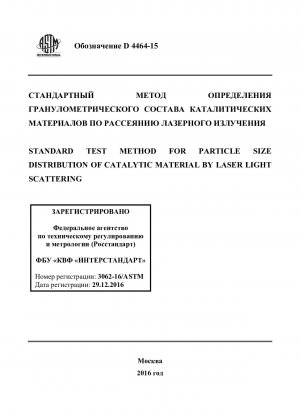ASTM D4464-15
Standard Test Method for Particle Size Distribution of Catalytic Materials by Laser Light Scattering
- Standard No.
- ASTM D4464-15
- Release Date
- 2015
- Published By
- American Society for Testing and Materials (ASTM)
- Status
- Replace By
- ASTM D4464-15(2020)
- Latest
- ASTM D4464-15(2020)
- Scope
5.1 It is important to recognize that the results obtained by this test method or any other method for particle size determination utilizing different physical principles may disagree. The results are strongly influenced by physical principles employed by each method of particle size analysis. The results of any particle sizing method should be used only in a relative sense and should not be regarded as absolute when comparing results obtained by other methods. Particularly for fine materials (that is, average particle size < 20 μm), significant differences are often observed for laser light scattering instruments of different manufacturers. These differences include lasers of different wavelengths, detector configuration, and the algorithms used to convert scattering to particle size distribution. Therefore, comparison of results from different instruments may be misleading.3
5.2 Light scattering theories (Fraunhofer Diffraction4 and Mie Scattering5) that are used for determination of particle size have been available for many years. Several manufacturers of testing equipment now have units based on these principles. Although each type of testing equipment utilizes the same basic principles for light scattering as a function of particle size, different assumptions pertinent to application of the theory and different models for converting light measurements to particle size, may lead to different results for each instrument. Furthermore, any particles which are outside the size measurement range of the instrument will be ignored, causing an increase in the reported percentages within the detectable range. A particle size distribution which ends abruptly at the detection limit of the instrument may indicate that particles outside the range are present. Therefore, use of this test method cannot guarantee directly comparable results from different types of instruments.
5.3 This test method can be used to determine particle size distributions of catalysts, supports, and catalytic raw materials for specifications, manufacturing control, and research and development work.
5.4 For fine materials (that is, average particle size < 20 μm), it is critical that Mie Scattering Theory be applied. This involves entering an “optical model” consisting of the “real” and “imaginary” refractive indices of the solid at the wavelength of the laser. The “imaginary” refractive index is also referred to as the “absorbance,” as it has a value of zero for transparent materials such as glass beads. For common materials and naturally occurring minerals (for example, kaolin), these values are known and published, and usually included in the manufacturer’s instrument manual (for example, as an appendix). For example, kaolinite measured at 589.3 nm has a “real” refractive index of 1.55. The absorbance (imaginary component) for minerals and metal oxides is normally taken as 0.001, 0.01 or 0.1. Many of the published values were measured at 589.3 nm (sodium light) but often values at other wavelengths are also given. Extrapolation, interpolation, or estimation to the wavelength of the laser being used can therefore be made.6
......
ASTM D4464-15 Referenced Document
- ASTM D3766 Standard Terminology Relating to Catalysts and Catalysis
- ASTM E105 Standard Practice for Probability Sampling Of Materials
- ASTM E1617 Standard Practice for Reporting Particle Size Characterization Data
- ASTM E177 Standard Practice for Use of the Terms Precision and Bias in ASTM Test Methods
- ASTM E456 Standard Terminology for Relating to Quality and Statistics
- ASTM E691 Standard Practice for Conducting an Interlaboratory Study to Determine the Precision of a Test Method
ASTM D4464-15 history
- 2020 ASTM D4464-15(2020) Standard Test Method for Particle Size Distribution of Catalytic Materials by Laser Light Scattering
- 2015 ASTM D4464-15 Standard Test Method for Particle Size Distribution of Catalytic Materials by Laser Light Scattering
- 2010 ASTM D4464-10 Standard Test Method for Particle Size Distribution of Catalytic Material by Laser Light Scattering
- 2000 ASTM D4464-00(2005) Standard Test Method for Particle Size Distribution of Catalytic Material by Laser Light Scattering
- 2000 ASTM D4464-00 Standard Test Method for Particle Size Distribution of Catalytic Material by Laser Light Scattering

Copyright ©2024 All Rights Reserved